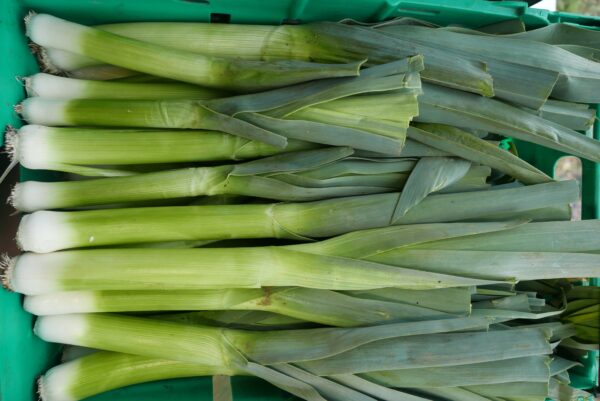
Leeks are not only beautiful but also rich in nutrients and essential antioxidants. They are a common vegetable worldwide, known for their fantastic versatility and enhancing the flavour and aroma of almost any dish.
We particularly enjoy growing them because they thrive in the coldest months when fewer vegetables are accessible. You can leave them in the ground throughout the winter, only harvesting as needed. This makes leeks a convenient and flavorful addition to meals, especially during colder seasons when other fresh vegetables are scarce.
A Legendary Hero and Healer
Leeks, initially cultivated by ancient Egyptians for grand feasts, were introduced to Europe by the Romans and continue to be prized in Britain. Hippocrates, the father of medicine, prescribed leeks for nosebleeds. Romans, deeming leeks superior, believed they enhanced singing; Emperor Nero consumed them for this reason.
In 640 AD, Welsh wearing leeks in battle against Saxons gained victory, establishing leeks as the Welsh national symbol. Associated with Saint David, leeks were considered virtuous, with mystical qualities. Hebrew’s leek word means ‘to be cut off,’ aligning with the Jewish tradition of consuming leeks at Rosh Hashanah.
Nutritionally, leeks are rich in vitamin K, protein, minerals, and energy, with raw consumption providing Thiamin and Vitamin B6.
How to Prepare and Store
Leeks grow straight up from the ground with flat leaves emerging from a rounded bulb, forming a layered, concentric pattern. To extend the white portion of the bulb, some growers mound soil around the base, resulting in soil between the leaves.
To clean leeks easily, cut them in half lengthwise and rinse under cold water, separating the layers and removing debris. Pat dry before use. For storage, wrap leeks in a damp paper towel and place them in a plastic bag in the fridge, where they can last up to two weeks.
While the white and pale green parts are commonly used, the darker green leaves are also edible, offering a slightly stronger flavour for stocks, stews, and stuffing.
A European Staple Vegetable
In Northern France, leeks play a key role in the beloved Potager Soup enjoyed during evening meals. Italians prefer baking blanched leeks in cream or braising them with dripping, sugar, and herbs. Both Italians and the French savour Leeks a la Grecque, cooked in olive oil, white wine, coriander seeds, and bay leaves. Belgians craft a tasty Flamiche Pie with cooked leeks, while Scots blend leeks with chicken in their Cock-a-Leekie Soup.
In Catalonia, the arrival of spring is celebrated with Calcot, a thin, spring onion-like leek, grilled outdoors and served with Romesco sauce. Vichyssoise, a renowned leek dish, originated with French chef Louis Diat at New York’s Ritz Carlton Hotel, inspired by his mother’s traditional recipe, and named after his hometown, Vichy.
Cooking with Leeks
- For grilling leeks, begin by slicing them in half lengthwise, ensuring a thorough rinse and drying before placing them on the grill. Cook both sides on medium-high heat until they achieve a well-charred and tender texture.
- For roasting, halve the leeks lengthwise, chop them into 1-inch chunks, and wash them using the previously mentioned method. Afterward, coat them in olive oil, salt, and pepper, then bake at 220c for approximately 20 minutes or until tender.
- To sauté leeks, heat a generous amount of olive oil in a large skillet over medium heat. Add the leeks and cook, stirring occasionally, until they soften—usually around 5 minutes.
- Incorporate leeks into soups, stews, and stocks to enhance depth and flavour. They can be used in place of or alongside onions. Here are some of our favourite leek-infused soup recipes: Curried Leek and Parsnip Soup, Leek, Celeriac, Potato and Apple Soup, Mushroom and Leek Soup
- For stuffing, the sweet, oniony flavour of leeks adds an irresistible touch. While they’re traditionally used to stuff meats, consider trying a separate Buttered Stuffing with Celery and Leeks for a delicious twist.
- In pasta dishes, leeks enhance the flavour of various vegetable combinations. Whether stir-fried, sautéed, or blended with cream, they make an excellent addition to the sauce for Italian-inspired dishes. Explore the simplicity of creating something delicious with leeks, such as this Caramelised Leek Pasta.
- In risotto, these tender alliums are a classic ingredient, lending creaminess and fragrance. Traditional combinations include leeks with mushrooms, peas, and cream. Try this Leek and Broccoli Risotto for a delightful variation.
- With eggs and on pizza – Sautéed leeks can be added to an omelet or scrambled eggs or used as topping to any homemade pizza
Here are more cooking inspirations from our Recipe Bank: Leek with Feta Borek (Pie), Leek and Potato Crustless Quiche, Poached Leeks with Walnut Vinaigrette, Creamed Leek, Chestnut and Thyme Crumble
Leeks Love
- Dairy: butter, cheese (Gruyere, Parmesan, and goat), cream.
- Spices & Herbs: thyme, tarragon, chives, garlic, mustard, and sage.
- Vegetables: carrot, potato, and mushrooms.
- Savoury: chicken, fish, eggs, sausage, lentils, pork (especially bacon), and rice.